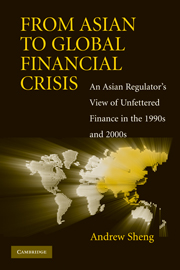 From Asian to Global Financial Crisis
From Asian to Global Financial Crisis Book contents
- Frontmatter
- Contents
- List of Figures
- List of Tables
- Acknowledgements
- Introduction
- 1 Things Fall Apart
- 2 Japan and the Asian Crisis
- 3 The Beam in Our Eyes
- 4 Banking: The Weakest Link
- 5 Washington Consensus and the IMF
- 6 Thailand: The Karma of Globalization
- 7 South Korea: Strong Body, Weak Heart
- 8 Malaysia: The Country That Went Its Own Way
- 9 Indonesia: From Economic to Political Crisis
- 10 Hong Kong: Unusual Times Need Unusual Action
- 11 China: Rise of the Dragon
- 12 From Crisis to Integration
- 13 The New World of Financial Engineering
- 14 What's Wrong with Financial Regulation?
- 15 The Global Financial Meltdown
- 16 A Crisis of Governance
- From Asian to Global Crisis: Chronology of Notable Events
- Abbreviations and Acronyms
- Bibliography
- Index
12 - From Crisis to Integration
Published online by Cambridge University Press: 05 June 2012
- Frontmatter
- Contents
- List of Figures
- List of Tables
- Acknowledgements
- Introduction
- 1 Things Fall Apart
- 2 Japan and the Asian Crisis
- 3 The Beam in Our Eyes
- 4 Banking: The Weakest Link
- 5 Washington Consensus and the IMF
- 6 Thailand: The Karma of Globalization
- 7 South Korea: Strong Body, Weak Heart
- 8 Malaysia: The Country That Went Its Own Way
- 9 Indonesia: From Economic to Political Crisis
- 10 Hong Kong: Unusual Times Need Unusual Action
- 11 China: Rise of the Dragon
- 12 From Crisis to Integration
- 13 The New World of Financial Engineering
- 14 What's Wrong with Financial Regulation?
- 15 The Global Financial Meltdown
- 16 A Crisis of Governance
- From Asian to Global Crisis: Chronology of Notable Events
- Abbreviations and Acronyms
- Bibliography
- Index
Summary
Empires wax and wane, states cleave asunder and coalesce.
~ Romance of the Three Kingdoms, Chinese 15th-century novelHow bad was the damage from the Asian crisis? This chapter looks at the damage incurred and the steps taken by Asia as a region to prevent the next crisis.
ASIA'S GROWING PAINS: NEVER AGAIN!
There are several ways to measure the damage of the Asian crisis, including the loss of annual GDP, wealth and jobs. Various studies suggest that the output loss was quite large, ranging from Japan (17.6 percent) to Malaysia (50.0 percent), South Korea (50.1 percent), Indonesia (67.9 percent) and Thailand (97.7 percent).
In terms of wealth losses, Japan suffered the most, being the largest economy in Asia, and the deflation was the most long drawn. According to Nomura's Chief Economist Richard Koo, the Japanese economy lost ¥1,200 trillion in wealth because of the massive fall in asset prices between 1989 and 1998, equivalent to 2.7 times Japan's 1989 GDP. Most of the wealth loss resulted from the drop in land prices, with the price of land in six major cities falling by 85 percent. American analyst Jim Rohwer was more blunt: ‘Japan's financial problem in a nutshell was that from the beginning of 1990 to the end of 1998 around $4.5 trillion worth of wealth in the stock market, and $11.5 trillion worth in the property market, was destroyed without anyone – government, banks or companies – being prepared to recognize the losses’.
- Type
- Chapter
- Information
- From Asian to Global Financial CrisisAn Asian Regulator's View of Unfettered Finance in the 1990s and 2000s, pp. 303 - 324Publisher: Cambridge University PressPrint publication year: 2009


